Your session is about to expire
Olanzapine Vs Zyprexa
Introduction
Understanding the differences between various brand names of medicines doesn't just help patients avoid negative side effects but can also considerably reduce the cost. The formulation and manufacturing process, along with other inactive ingredients, can change the composition of the drug, making it unfit for some patients. Thus, researching the brand name and consulting a doctor is essential.
Olanzapine, which has been introduced to the public under the name Zyprexa, is a highly effective medication used to manage psychosis that results from schizophrenia or bipolar disorder. It is an atypical antipsychotic, which means it works on managing the chemicals within the brain to reduce symptoms of psychosis.
Moreover, Olanzapine is often used to manage positive symptoms of schizophrenia, which include but are not limited to hallucinations and delusions. Moreover, it can also be highly effective for patients looking to manage thinking patterns and mood instability.
However, some brand names of Olanzapine may cause serious side effects to certain patients. This is why more than one brand name exists in the market. Zyprexa, one brand of Olanzapine, works at blocking specific dopamine and serotonin receptors for neurotransmitters in the brain. This intervention improves the quality of life of patients suffering from mood instability and issues with cognition.
It is also based on past research that has suggested positive symptoms of schizophrenia almost always result from an increased subcortical release of dopamine. Since Olanzapine targets both dopamine and serotonin, it is much more effective at achieving the balance required for healthy brain activity.
About Olanzapine and Zyprexa
What is Olanzapine?
Olanzapine is categorized under the wide varieties of atypical antipsychotics in the world. This medicine is usually utilized in the treatment of disorders that result from an imbalance in neurotransmitters. Olanzapine is most effective for bipolar disorder and schizophrenia. By acting on neurotransmitters in the brain, it can effectively reduce positive symptoms of schizophrenia, such as hallucinations, delusions, and disorganized thinking.
It can also be used to regulate moods for patients with bipolar disorder. Doctors may alter dosage depending on the patient's condition. Moreover, the dosage can also be tapered off with time as the patient's response to the medication is observed. Keep in mind that Olanzapine may cause side effects, so it is always important to visit the doctor if you experience any physical symptoms that did not exist before the medicine.
Olanzapine is used and marketed under different brand names, including Zyprexa. The others include:
- Zyprexa Zydis
- Olanzapine Teva
- Olanzapine Lupin
- Olanzapine Mylan
- Olanzapine Glenmark
- Olanzapine Accord
- Olanzapine Apotex
- Olanzapine Actavis
- Olanzapine Sandoz
What Conditions Is Olanzapine Approved To Treat?
Olanzapine is approved for treating different kinds of severe mental health conditions, which include the following:
- Schizophrenia: Perhaps the most common usage of Olanzapine is in the treatment of schizophrenia, which usually leads to both positive and negative symptoms. These include distorted thoughts, hallucinations, different kinds of delusions, and more.
- Bipolar Disorder: Olanzapine can also be used to stabilize moods in patients with bipolar disorder. It is useful in balancing moods and helping patients avoid periods of mania and depression.
- Severe Depression: Olanzapine is not just useful as an antipsychotic but can also be used in combination with other drugs to alleviate the symptoms of major depression.
- Anxiety: This drug is often used to treat generalized or social anxiety in patients who do not respond to other kinds of treatment. It has also been used to manage symptoms of post-traumatic stress disorder in the past.
Keep in mind that Olanzapine should only be used following the recommendation of a medical professional and as per the patient's needs. Increasing or discontinuing dosage without consulting a doctor may lead to serious side effects.
How Does Olanzapine Work for Schizophrenia?
Olanzapine reduces or eliminates the symptoms associated with schizophrenia by targeting the activity of certain neurotransmitters in the brain and modifying it to achieve optimal balance. By balancing dopamine and serotonin, Olanzapine can effectively address symptoms of the disease. However, the medical community hasn't fully understood the way it works, and further research is required to understand its full effects.
Olanzapine is particularly effective at reducing the positive symptoms of the disease. Schizophrenia is categorized by an imbalance of dopamine neurotransmitters in the brain. When levels of dopamine increase, symptoms of hallucinations, delusions, and disorganized thought patterns become common.
Olanzapine works on blocking the D2 receptors, which reduces unnecessary dopamine activity. This achieves the balance that is required for the treatment of schizophrenia. Olanzapine is also effective as it performs a dual function; it doesn't just manage dopamine but also affects serotonin receptors, such as the 5-HT2A receptor, which eventually reduces psychosis and other symptoms.
What is Zyprexa
Zyprexa is a brand name for Olanzapine, and it is one of the many different brand names that exist for this medicine. While the different brand names of Olanzapine may contain Olanzapine as an active ingredient, notable differences that are worthy of consideration exist.
Zyprexa is an Eli Lilly and Company product, while other brand names are usually associated with different companies. Some patients prefer relying on a specific company due to the efficacy demonstrated in their clinical trials.
Moreover, Zyprexa may also be easily available in the required unique dosage and form. This is because it is available in various dosages and forms, including Zydis, which is an orally disintegrating tablet. It is common for patients to rely on different brand names when they are unable to find a dosage that suits their requirements.
It is important to note that the inactive ingredients within certain brand names may differ. This includes the fillers, binders, and coatings. Patients may have allergies to certain inactive ingredients, so it is always a good idea to consult a doctor and provide all the information required for them to suggest a brand name.
What Conditions Is Zyprexa Approved to Treat?
Zyprexa is approved to treat the same conditions as listed above under Olanzapine. This is because it is the brand name of Olanzapine. This means that it can treat symptoms of schizophrenia and be effective in managing positive and negative symptoms. It can also act as a mood regulator in patients with bipolar disorder. Moreover, it is often used off-label for diseases like severe anxiety and depression that don't respond to other medications.
How Does Zyprexa Work for Schizophrenia?
Subtle differences exist between different brand names that come under the vast umbrella of Olanzapine. Although Olanzapine is an active ingredient in all brand names, one must still consult the doctor before switching to a new brand name.
Zyprexa is an atypical antipsychotic that may be different from other brand names of Olanzapine. Although all brand names work similarly, Zyprexa is formulated slightly differently and is much more widely available in terms of dosage requirements. Moreover, Zyprexa is also dissolved and used by the body in slightly different ways than other brand names. The side effects may also differ depending on your allergies.
Effectiveness
How Effective Are Olanzapine and Zyprexa for Treating Schizophrenia?
The effectiveness of Olanzapine (brand name Zyprexa) has been established over time in multiple studies and literature reviews. Clinical trials conducted in 1997 demonstrated the efficacy of Zyprexa, which improved both positive and negative symptoms of the illness. Within the study, patients also demonstrated a vast improvement in symptoms of depression. Moreover, when compared to haloperidol, Olanzapine was much better at preventing relapse. Significant improvements found within the trial increased the reliability of the drug.
Another study published in 2008 tested patients of schizophrenia with Olanzapine. This study was conducted to understand the efficacy and safety of the drug. 81 patients were included in the clinical study with an average dose of 9.4 ± 3.6 mg/day. 86.4% of patients experienced at least a slight improvement, if not better, in their symptoms. 14.8% of patients experienced a remarkable movement, while 59.3% reported a moderative improvement or better. The medicine effectively managed both positive and negative symptoms of the disease.
A 2019 study reported even better findings. This literature review also aimed to understand the efficacy of Olanzapine compared to other antipsychotics. It found that Olanzapine was particularly effective at treating symptoms and preventing treatment discontinuation.
Dosage information
How is Olanzapine Administered for Schizophrenia?
Olanzapine Dosage Information
Recommended dosages of Olanzapine differ depending on the condition along with the individual's medical history. Certain factors may lead to an adjusted dose or discontinuation if any side effects are experienced.
Moreover, the dosage may also differ depending on the brand name recommended to the patient. Discussing your requirements and medical history with your doctor before following dosages is essential. The average dosage for adults who are starting to consume Olanzapine is usually 5 to 10 mg daily. However, this can increase with time.
Here are some of the average doses recommended for different diseases;
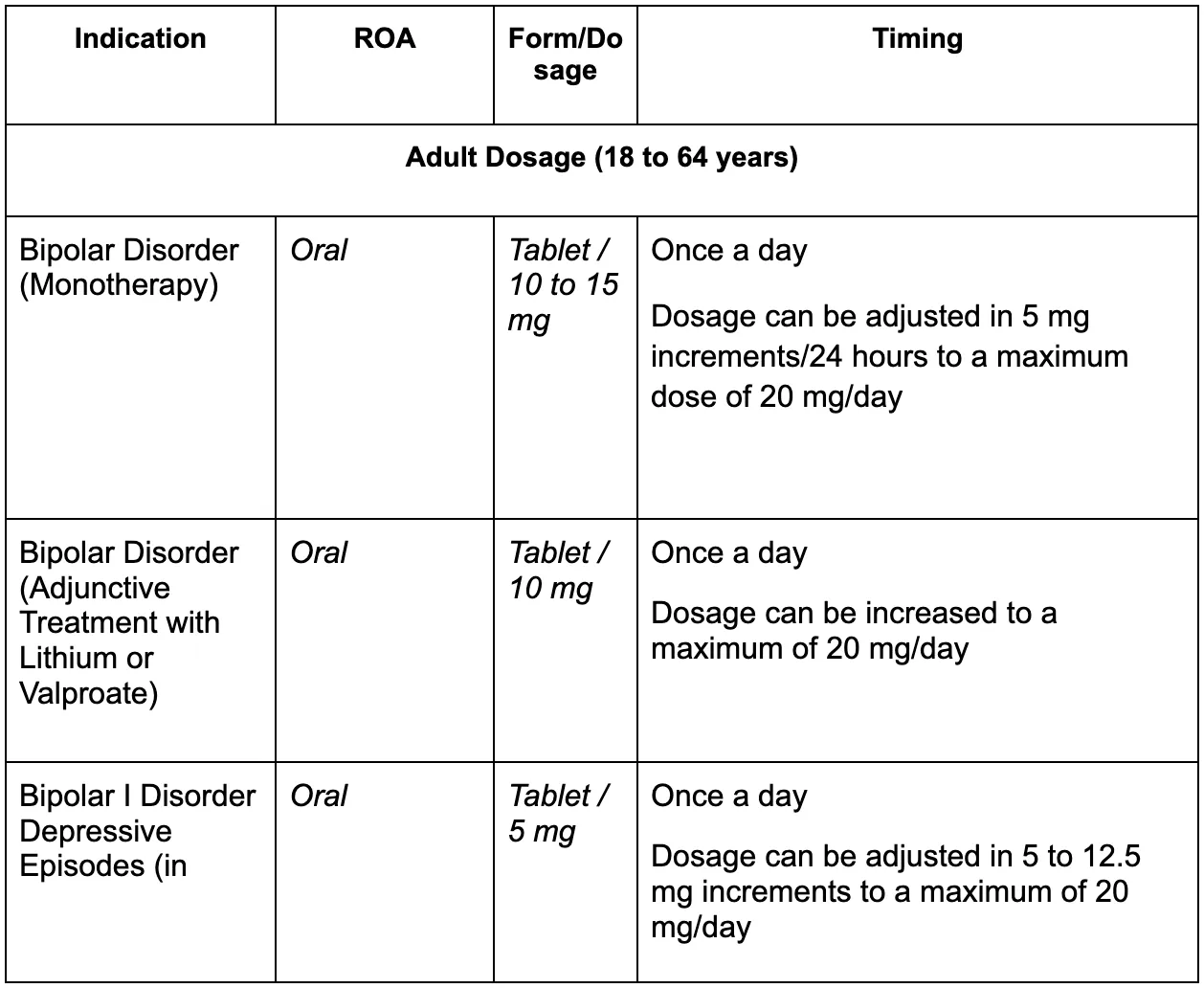

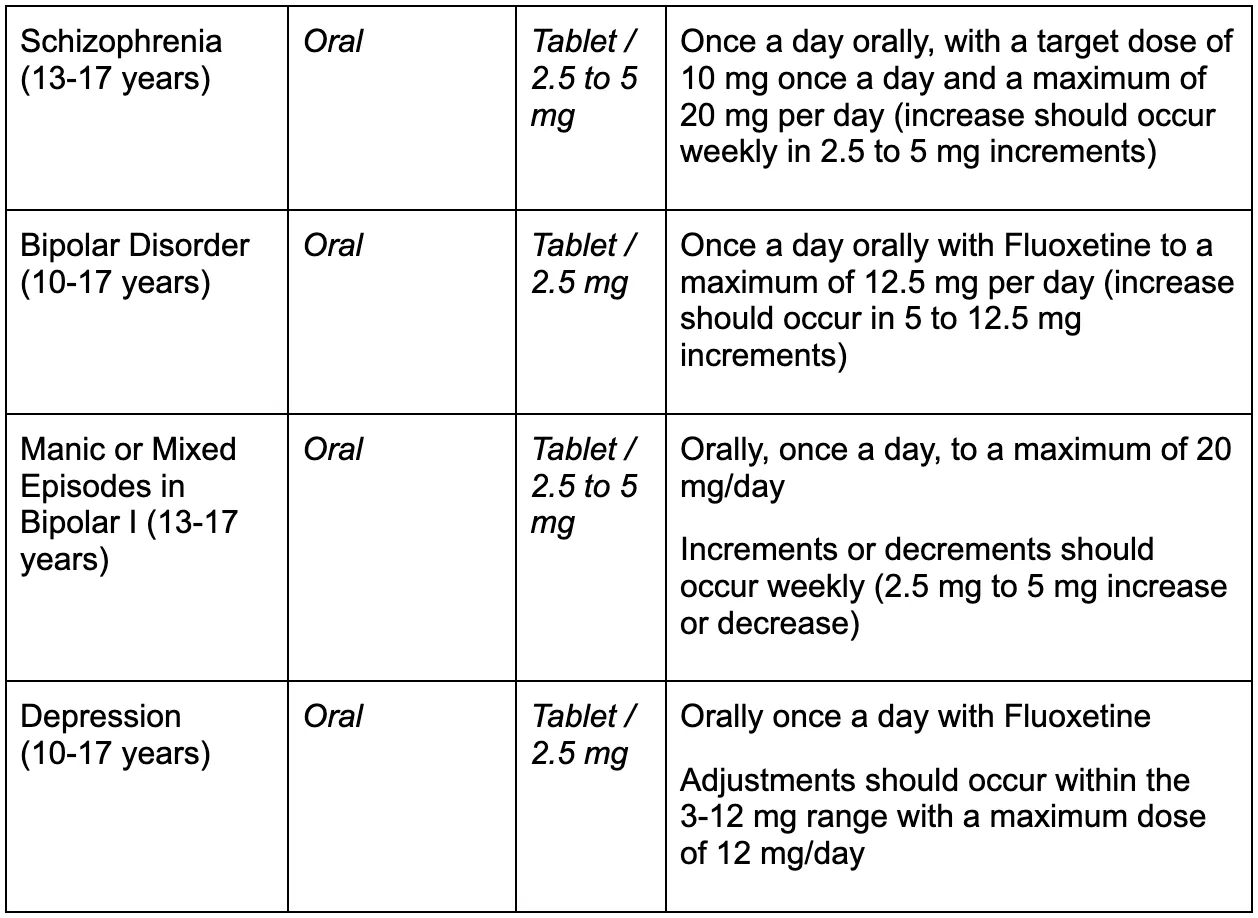
How is Zyprexa Administered for Schizophrenia?
Zyprexa dosage information
Zyprexa is generally administered once a day with no meal requirements. 5 to 10 mg are administered first, with a target dose of 10 mg daily. Dosage is increased or decreased depending on the patient's requirements. Increments or decrements of 5 mg are recommended.
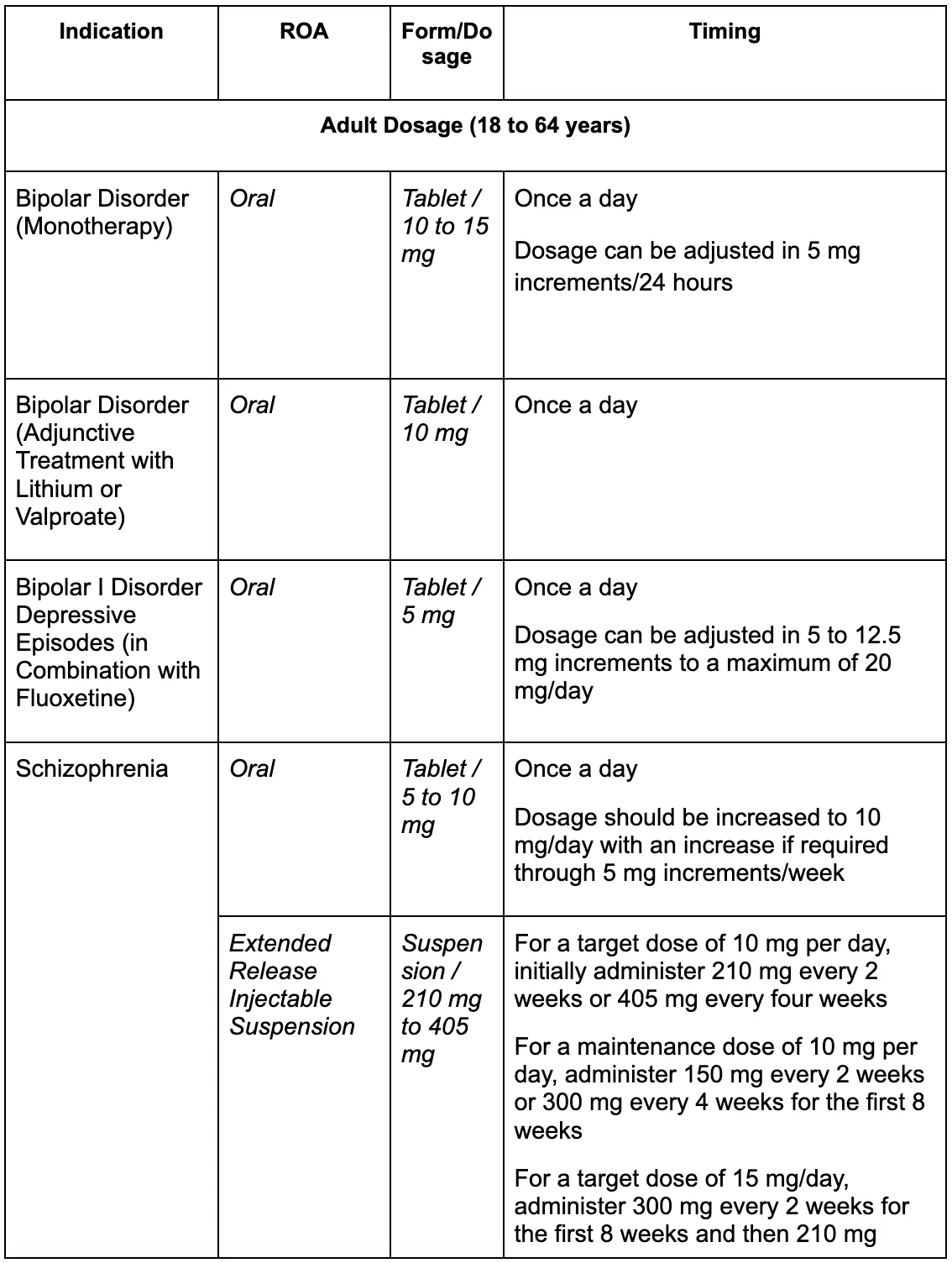
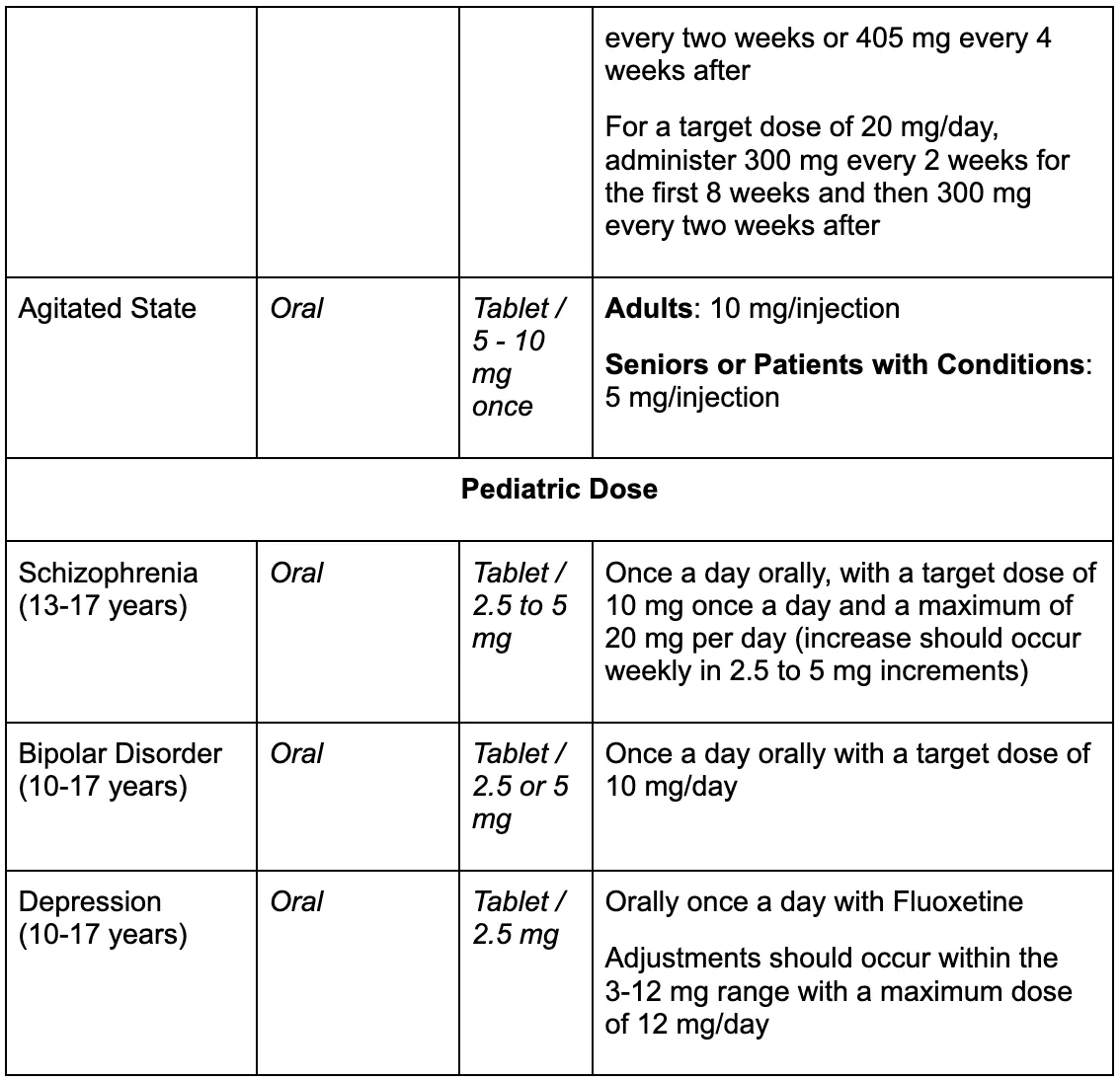
Side Effects
The following list isn't exhaustive. It does not include all possible side effects. However, it does cover an extensive number of effects that can get serious. It is important that you visit your doctor if you are experiencing any of the serious side effects mentioned below;
What Are the Most-Common Side Effects of Olanzapine?
- Increased hunger
- Drowsiness and feeling tired
- Dry mouth
- Weight gain
- Constipation
- Feeling lightheaded
- Restlessness
- Stiff muscles
- Muscle tremor
- Blurred vision
Are There Any Potential Serious Side Effects of Olanzapine?
* If you experience any of these serious side effects, seek medical help immediately
- Neuroleptic Malignant Syndrome: This is categorized by stiff muscles, altered mental state, fever, and dysfunction of the autonomic nervous system (inability to regulate heartbeat, breathe, move, etc.)
- Increase blood sugar
- Sudden weight gain
- Change in cholesterol levels
- Hyperprolactinemia: This causes symptoms such as breast enlargement, sexual dysfunction, disruption of the menstrual cycle, and more.
- Tardive Dyskinesia: Involuntary movement of the face or body.
- Seizures
Olanzapine is not recommended for women who are currently pregnant. If you have become pregnant while using this medication, inform your doctor immediately.
What Are the Most-Common Side Effects of Zyprexa?
Refer to the list of side effects mentioned under Olanzapine.
Are There Any Potential Serious Side Effects of Zyprexa?
* If you experience any of these serious side effects, seek medical help immediately
Refer to the list of side effects mentioned under Olanzapine.
Contraindications and Interactions
Warnings and General Precautions for Olanzapine and Zyprexa
Zyprexa (Olanzapine) is an atypical antipsychotic which comes with certain warnings and general precautions every patient should consider. However, this list of warnings is not exhaustive, and speaking to a doctor before relying on a medicine is always important.
Note that Zyprexa is not recommended for adults who have been diagnosed with dementia, as it can increase mortality. Moreover, Zyprexa should also be avoided by women who are pregnant or breastfeeding. In certain cases, your doctor may allow you to consume the medication. However, only a medical professional can weigh the potential risks and benefits and guide you accordingly.
Zyprexa also interacts negatively with certain medications, including antidepressants, seizure medication, and others. You must discuss your medical history with your doctor and provide them with a list of the medications you consume to avoid side effects.
Some of the contraindications and important interactions include:
Contraindications and important interactions for Olanzapine and Zyprexa
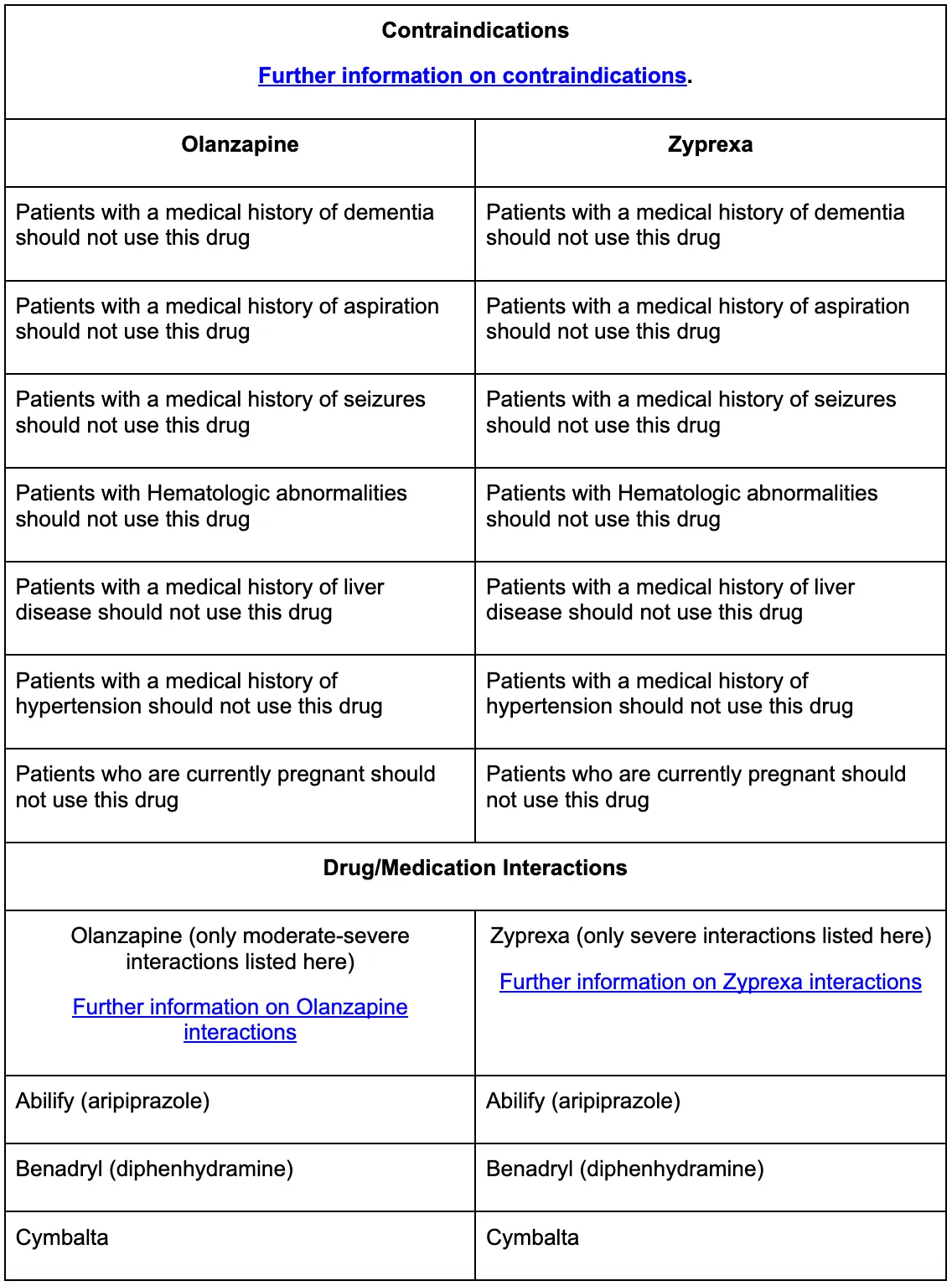

Cost Comparison
How much do Olanzapine and Zyprexa cost?
Zyprexa typically costs $28 per packet containing 30 tablets (10 mg each). However, the average cost of Olanzapine is $3.49 per unit since many other brand names provide a lower-cost option. The specific brand name your doctor recommends depends on your requirements.
Moreover, the cost per month also depends on your dosage as per your condition. However, for a patient taking 20 mg of Zyprexa per day, in tablet form orally, it would cost $60 per month.
Popularity of Olanzapine and Zyprexa
Olanzapine ranks at #164 in the list of top drugs in the USA. It also sold 3,498,182 prescriptions to 634,470 patients in 2020. This puts it at number 4 in the list of drugs with the most prescriptions sold, with Quetiapine at number 1 with 10,574,792 prescriptions sold.
Conclusion
Takeaway
While Zyprexa has delivered both efficacy and safety in its clinical trials over the years, other brand names of Olanzapine may provide better results for some patients with unique allergies or dosage and other requirements. Speaking to a medical professional before relying on a dose is important.
Moreover, the efficacy and safety of a drug should come second to a patient's individual reaction to the chemical composition. Any side effects should be reported to a medical professional as soon as possible to avoid serious consequences.